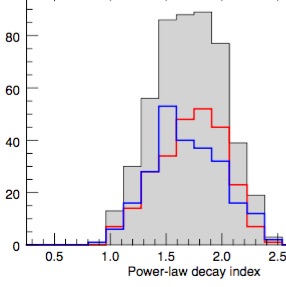Analysing the cooling tails of thermonuclear bursts
 When the upper layer of an accreting neutron star experiences a thermonuclear
runaway of helium and hydrogen, it exhibits an X-ray burst with a
cool-down phase of typically 1 minute.
Analysis of light curves of 1254
X-ray bursts observed by the
Rossi X-ray
Timing Explorer
shows that the decay is described as a power-law with
index in the range 1.3—2.1,
with a Gaussian component also required for half of the bursts.
The Gaussian appears consistent with being due to the rp
process,
which consists of rapid proton captures and slow beta-decays of
proton-rich isotopes, and is expected to be prominent in bursts with a
significant fraction of hydrogen in the fuel.
The Gaussian fluence fraction suggests that the layer where the rp
process is active is underabundant in H by a factor of at least five with
respect to cosmic abundances.
Jean's paper reporting the analysis is now accepted by A&A.
When the upper layer of an accreting neutron star experiences a thermonuclear
runaway of helium and hydrogen, it exhibits an X-ray burst with a
cool-down phase of typically 1 minute.
Analysis of light curves of 1254
X-ray bursts observed by the
Rossi X-ray
Timing Explorer
shows that the decay is described as a power-law with
index in the range 1.3—2.1,
with a Gaussian component also required for half of the bursts.
The Gaussian appears consistent with being due to the rp
process,
which consists of rapid proton captures and slow beta-decays of
proton-rich isotopes, and is expected to be prominent in bursts with a
significant fraction of hydrogen in the fuel.
The Gaussian fluence fraction suggests that the layer where the rp
process is active is underabundant in H by a factor of at least five with
respect to cosmic abundances.
Jean's paper reporting the analysis is now accepted by A&A.
Read the paper arXiv:1708.08644
Labels: 2017, /thermonuclear bursts




